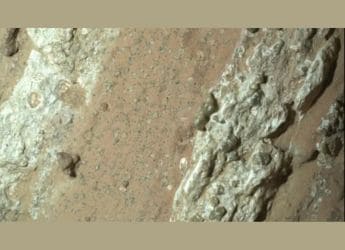- Home
- Science
- Science News
- New Mars Water Map Shows Traces of Ancient Water, Might Help Locate Landing Sites For Future Missions
New Mars Water Map Shows Traces of Ancient Water, Might Help Locate Landing Sites For Future Missions
The Mars water map makes it clear that water had a significant role to play in shaping the Red Planet's geology.

Photo Credit: ESA/NASA
Researchers used data from ESA's OMEGA and NASA's CRISM instruments
The ongoing quest for signs of ancient life on Mars has seen several landers, orbiters, and spacecraft attempt to gain deeper knowledge about the Red Planet. Now, scientists have utilised data collected over a decade by NASA and the European Space Agency (ESA) to create a water map of the planet. Featuring sites of aqueous minerals, the map sheds light on the ancient traces of water on Mars and is expected to help scientists zero in on locations ideal for landing future Mars missions. Pieced together meticulously, the map shows a location with an abundance of aqueous minerals. These minerals are the result of rocks that were chemically altered by the action of water on them in the past.
The interaction between rocks and water leads to the formation of clay on Earth, and different conditions can result in diverse types of clays. When the amount of water is more, the soluble elements tend to wash away leaving behind clays such as kaolin that are rich in aluminium. The new map features thousands of sites in the oldest regions of Mars containing such minerals.
To create the map, researchers used data from the ESA's OMEGA instrument and the Mars Reconnaissance Orbiter Compact Reconnaissance Imaging Spectrometer for Mars (CRISM) instrument of NASA. Working in the same wavelength range and having sensitivity to the same minerals, both instruments proved to be ideal for the mapping.
Previously, it was known that aqueous minerals were present in smaller numbers on the planet indicating that water was limited in both extent and duration. Now, the map has made it clear that water had a significant role to play in shaping the geology around the Red Planet.
“I think we have collectively oversimplified Mars,” said planetary scientist John Carter of the University of Paris-Saclay. He added that initially, it was thought that only a few types of clays formed on Mars during the wet period, but the new map even features some intimate mixing of salts and clays and some salts that could be older than some clays.
The findings have been published in two papers in the journal Science Direct.
Get your daily dose of tech news, reviews, and insights, in under 80 characters on Gadgets 360 Turbo. Connect with fellow tech lovers on our Forum. Follow us on X, Facebook, WhatsApp, Threads and Google News for instant updates. Catch all the action on our YouTube channel.
Related Stories
- Samsung Galaxy Unpacked 2025
- ChatGPT
- Redmi Note 14 Pro+
- iPhone 16
- Apple Vision Pro
- Oneplus 12
- OnePlus Nord CE 3 Lite 5G
- iPhone 13
- Xiaomi 14 Pro
- Oppo Find N3
- Tecno Spark Go (2023)
- Realme V30
- Best Phones Under 25000
- Samsung Galaxy S24 Series
- Cryptocurrency
- iQoo 12
- Samsung Galaxy S24 Ultra
- Giottus
- Samsung Galaxy Z Flip 5
- Apple 'Scary Fast'
- Housefull 5
- GoPro Hero 12 Black Review
- Invincible Season 2
- JioGlass
- HD Ready TV
- Laptop Under 50000
- Smartwatch Under 10000
- Latest Mobile Phones
- Compare Phones
- Honor Win RT
- Honor Win
- Xiaomi 17 Ultra Leica Edition
- Xiaomi 17 Ultra
- Huawei Nova 15
- Huawei Nova 15 Pro
- Huawei Nova 15 Ultra
- OnePlus 15R
- Asus ProArt P16
- MacBook Pro 14-inch (M5, 2025)
- OPPO Pad Air 5
- Huawei MatePad 11.5 (2026)
- Xiaomi Watch 5
- Huawei Watch 10th Anniversary Edition
- Acerpure Nitro Z Series 100-inch QLED TV
- Samsung 43 Inch LED Ultra HD (4K) Smart TV (UA43UE81AFULXL)
- Asus ROG Ally
- Nintendo Switch Lite
- Haier 1.6 Ton 5 Star Inverter Split AC (HSU19G-MZAID5BN-INV)
- Haier 1.6 Ton 5 Star Inverter Split AC (HSU19G-MZAIM5BN-INV)

















